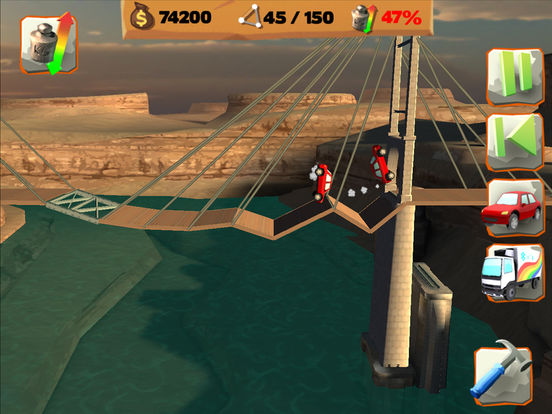

- BRIDGE CONSTRUCTOR PLAYGROUND TUTORIA BRIDGE 6 CODE
- BRIDGE CONSTRUCTOR PLAYGROUND TUTORIA BRIDGE 6 FREE
write( dataByte) // new data to put into that memory register write( registerAddress) // command byte to target the register location beginTransmission( deviceAddress) // Attention sensor deviceAddress! Writing a byte to a sensor’s control register can be done with four basic steps: 0b00001111) so you can see the on/off states when you read through your code. Most people use byte variables for the sensor’s bus and register memory addresses, but once you’ve figured out the pattern you need to set up in control register switch-bits, it helps to write that information as a long form binary number (eg. This can potentially change eight of those control switches simultaneously and, for parameters that are controlled by more than one bit, sometimes it’s actually required that you set them in one register-writing operation. These can add an extra layer of control settings to take care of when you initialize the sensor.Īrduino’s wire library can only transfer 8-bit bytes over the I☬ bus, so that’s the smallest amount of information you can write into a register memory location at one time. And sometimes there are “special chip functions” that perform some kind of post processing on those sensor readings that would be hard to replicate on the Arduino. I☬ chip-based sensors often have a dozen or more operational settings for things like bit-depth, sampling speed, noise reduction, etc., so you usually need to set bits in several different control registers before you can actually take a reading.

Think of control registers as banks of On/Off switches, which you turn on by setting a bit to 1 and turn off by setting that bit to 0. Most sensors change how they operate based on the values stored in control registers. The functions named with the i2c_ prefix should be generic enough to work with most I☬ sensors, but I’ll also be referring to a few specific cases to show how you might need to modify those basic functions.
BRIDGE CONSTRUCTOR PLAYGROUND TUTORIA BRIDGE 6 CODE
There are many kinds of registers but for this introduction I am going to group them into three general types: Control, Data and Status registers, and provide brief examples of code that you can use to work with each of them.

All of this, paired with a bright and friendly look, makes Bridge Constructor Playground an exciting and also educational experience for the whole family, offering hours of gaming fun.Even if you’ve never worked with registers before, jrowberg’s visual grid layout makes it easy to see how the sensor’s memory is divided into sections, which are doing different things. For example, building a bridge that can carry no more than a certain load limit. Experienced players will enjoy the challenges of the new badge system: for every bridge there are 5 badges to be won for which you must fulfill certain requirements.
BRIDGE CONSTRUCTOR PLAYGROUND TUTORIA BRIDGE 6 FREE
Here you are free to do as you please and let the time fly by with creative bridge building. With no fixed budget, and next to no limitations on building materials, there are almost no limits: you can build and construct to your heart’s desire. Following this your bridges will be subjected to a stress test to see whether they can support the weight of the cars and/or trucks which drive across them.In comparison to the #1 hit Bridge Constructor, Bridge Constructor Playground offers an even easier entry to the game incl. Across 30 innovative levels you have to build bridges over deep valleys, canals or rivers. This game gives you the freedom to let your creative side run riot – nothing is impossible. Across 30 innovative levels you +++ Now 66.6% off for a limited time +++Bridge Constructor Playground offers people of all ages an introduction to the topic of “bridge building”.

Summary: +++ Now 66.6% off for a limited time +++Bridge Constructor Playground offers people of all ages an introduction to the topic of “bridge building”.


 0 kommentar(er)
0 kommentar(er)
